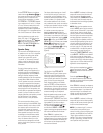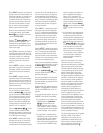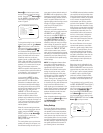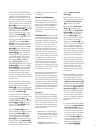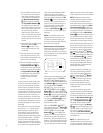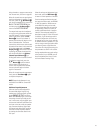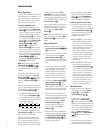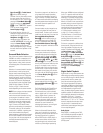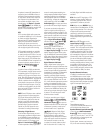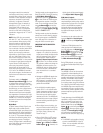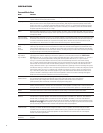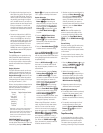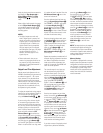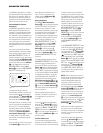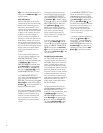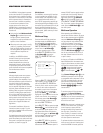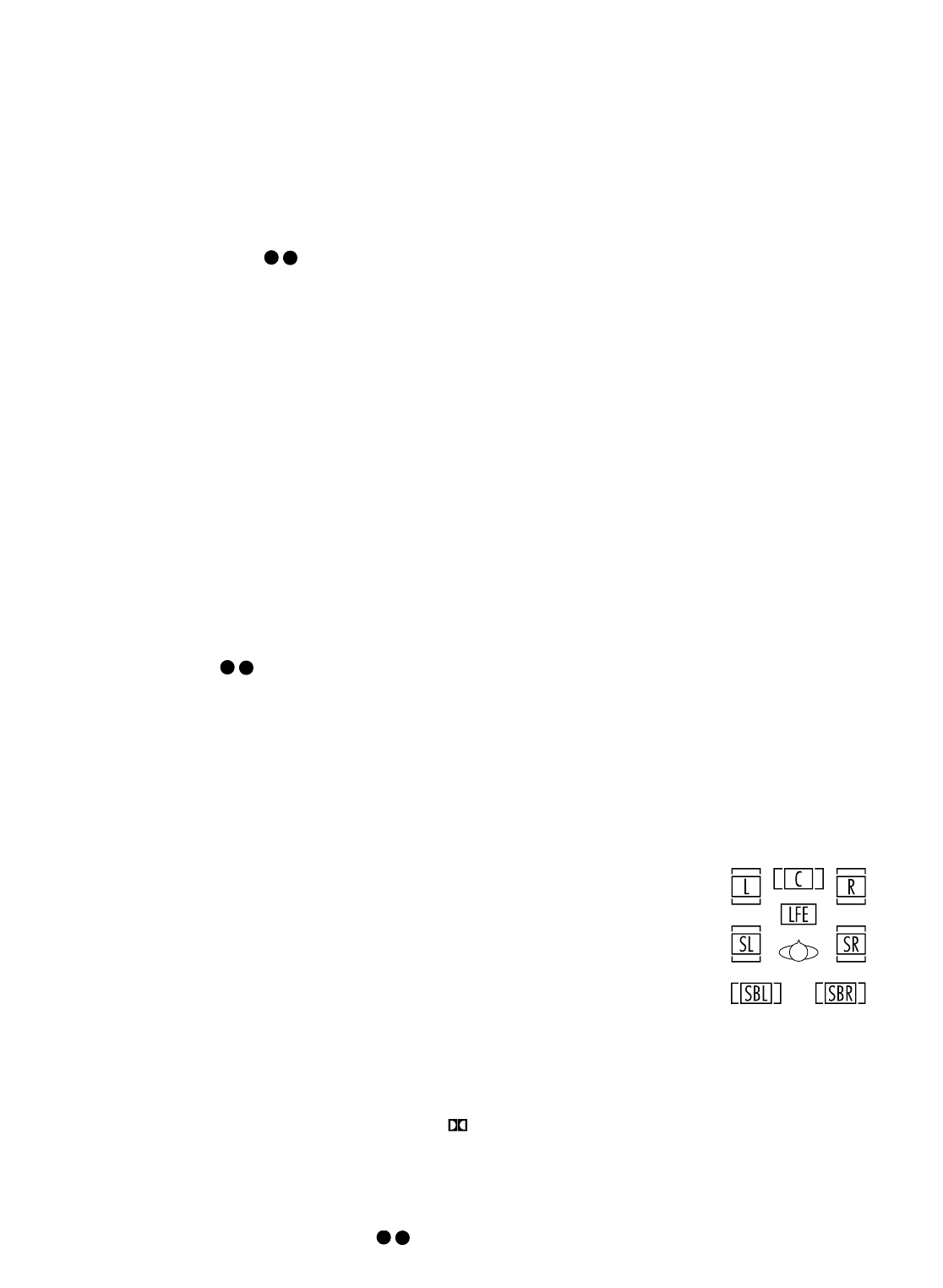
32
An optional, external RF demodulator is
required to use the AVR580 to listen to
the Dolby Digital soundtracks available
on laser discs. Connect the RF output of
the LD player to the demodulator and
then connect the digital output of the
demodulator to the
Optical or Coaxial
Inputs
&* of the AVR580. No
demodulator is required for use with DVD
players or DTS-encoded laser discs.
DTS
DTS is another digital audio system that
is capable of delivering 5.1 or 6.1 discrete
or matrix sound field reproduction.
Although both DTS and Dolby Digital are
digital, they use different methods of
encoding the signals, and thus they
require different decoding circuits to con-
vert the digital signals back to analog.
DTS-encoded soundtracks are available
on select DVD and LD discs, as well as
on special audio-only DTS discs. You may
use any LD or CD player equipped with a
digital output to play DTS-encoded discs
with the AVR580. All that is required is to
connect the player’s output to either an
Optical or Coaxial Input on the rear
panel or front panel
&*.
In order to listen to DVDs encoded with
DTS soundtracks, the DVD player must be
compatible with the DTS signal as indi-
cated by a DTS logo on the player’s front
panel. Early DVD players may not be able
to play DTS-encoded DVDs. This does not
indicate a problem with the AVR580, as
some players cannot pass the DTS signal
through to the digital outputs. If you are
in doubt as to the capability of your DVD
player to handle DTS discs, consult the
player’s owner’s manual.
NOTE: Some DVD players have a default
setting that does not pass through the
DTS signal. Before playing DVDs with a
DTS soundtrack, make certain that the
settings in your DVD player have been
properly adjusted
so that DTS audio is
passed through. Consult the owner’s
manual for your DVD player for more
information on making these settings.
Selecting a Digital Source
To utilize either digital mode, you must
have properly connected a digital source
to the AVR580. Connect the digital out-
puts from DVD players, HDTV receivers,
satellite systems or CD players to the
Optical or Coaxial Inputs &* .
In order to provide a backup signal and a
source for analog stereo recording, the
analog outputs provided on digital source
equipment should also be connected to
their appropriate inputs on the AVR580
rear panel (e.g., connect the analog stereo
audio output from a DVD to the
DVD
Audio Inputs
k on the rear panel when
you connect the source’s digital outputs).
If you have not already configured an
input for a digital source using the on-
screen menus as shown on page 22, first
select the input using the remote or front-
panel controls as outlined in this manual.
Next, select the digital source by press-
ing the
Digital Select Button qP
and then using the
⁄
/
¤
Buttons n
on the remote or the
‹
/
›
Selector
Buttons
)# on the front panel to
choose any of the OPTICAL or
COAXIAL
inputs, as they appear in
the
Upper Display Line A or on-screen
display. When the digital source is play-
ing, the AVR580 will automatically detect
which type of digital data stream is being
decoded and display that information in
the
Upper Display Line A.
Digital Bitstream Indicators
When a digital source is playing, the
AVR580 senses the type of bitstream data
that is present. Using this information, the
correct surround mode will automatically
be selected. For example, DTS bitstreams
will cause the unit to switch to DTS
decoding, and Dolby Digital bitstreams
will enable Dolby Digital decoding. When
the unit senses PCM data from CDs and
LDs, it will allow the appropriate surround
sources to be selected manually. Since
the range of available surround modes is
dependent on the type of digital data that
is present, the AVR580 uses display indi-
cators to let you know what type of signal
is present. This will help you to under-
stand the choice of modes.
To help you see which type of digital
source is playing, the
Surround Mode
Indicators
˘ in combination with the
Information Display ˜ also serve as
bitstream indications to show which type
of bitstream is present, as well as the
surround mode in use, if applicable.
Digital: When the Dolby Digital
or Dolby Digital EX logo is lit, a Dolby
Digital bitstream is being received.
Depending on the settings on the source
player and specific surround information
and number of channels on the disc,
a number of surround modes are possi-
ble. For discs with full 5.1 audio, only
the Dolby Digital and VMAx modes are
available.
DTS: When the DTS logo lights, a DTS
bitstream is being received. When the
unit senses this type of data, only the
applicable DTS mode may be used.
PCM: When the word DIGITAL lights, a
standard Pulse Code Modulation, or PCM,
signal is being received. This is the type
of digital audio used by conventional
compact disc and laser disc recordings.
When a PCM bitstream is present, all
modes except Dolby Digital and DTS are
available.
MP3: When MP3 appears on the
Lower Display Line B a compatible
MPEG 1/Layer 3 digital signal is being
received. This is the popular audio format
used by many computer programs for
recording compressed audio files. When
an MP3 bitstream is present, the sound
will automatically be played in the Stereo
(Surround Off) mode. The surround modes
are not available during MP3 playback.
There are many different forms of MP3
encoding available and the format is used
at a number of different bit rates. The
AVR580 may not be compatible with all
forms of MP3, particularly when the data
file is encoded at 128kb/s or above.
Speaker/Channel Indicators
In addition to the bitstream indicators,
the AVR580 features a set of unique
channel-input indicators that tell you how
many channels of digital information are
being received and/or whether the digital
signal is interrupted. (See Figure 9.)
Figure 9
These indicators are the
L/C/R/LFE/SL/SR/SBL/SBR letters that
are inside the center boxes of the
Speaker/Channel Input Indicators E
in the front-panel Main Information
Display
˜. When a standard analog
signal is in use, only the “L” and “R” indi-
cators will light, as
analog signals have
only left and right channels.
Digital signals, however, may have two,
five, six or seven channels, depending on
34
31
34
31
34
31



